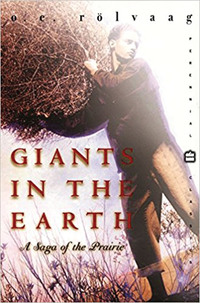A lone wagon rolls across an endless sea ofgrass, amidst the endless sound of wind. On the horizon, unfettered by tree or mountain, the setting sun explodes into hues of orangeand violet, and to the settlers it seems they have passed into another realm, beyond the edge of the map. In fact, the sky seems so big in this place that they might not be traveling on the earth, but into the sky itself.
In a nutshell, that is how O.E. Rølvaag begins his novel Giants in the Earth. Written in 1924-25 and translated from Norwegian, it is the story of a Norwegian family that comes to settle in southern Dakota Territory in the 1870s. Per Hansa, his wife Beret and their children struggle against time, locusts, the changing seasons, and themselves to survive in the strange wilderness of North America.
For writers who have written themselves into a corner, Chandler’s Law says: “When in doubt, have a man come through the door with a gun in his hand.” Rølvaag basically wrote the antithriller, here. It is a slow book, and that is the point. The very lack of action gets you into the mindset of the settlers in a profound way.
The daunting realities of homesteading setin for Per Hansa, who feverishly works against the little time they have before winter to make hay, to turn virgin soil, to build shelter. Despite all of the work, time moves maddeningly slow for Beret, who thinks always of the home and family she left behind in Norway. Living in the antithesis of an urban setting, isolation preys on her mind. The lack of ministry in the area also causes her to believe that her husband has taken them to live in a Godless desolation.
As the book progresses, Beret’s depression deepens, as does her religiosity. Per Hansa’s emotional stoicism, along with the demands of the homestead, make him increasingly unable to reach out to his wife.
Rølvaag writes about these emotions in a surprisingly organic way. I can think of very few books that can successfully recreate these feelings in the mind of the reader. There were also some moments where I felt that Rolvaaghad somehowmysticallybeen able toresurrect theexperiences ofthose Europeansettlers,experiences which have passed beyond living memory. What was more striking yet were the emotional chords of farm life that echo eventoday. Although I grew up on a family farm inthe 1990s, I found myself able to empathize with the consequences of stoicism, depression, the lack of family time, and the arguments that had started because of too much work and had to end abruptly for the same reason. Giants in the Earth is stocked with fully rounded characters, intimate descriptions of raw and unbridled nature (a character in itself), and a sense that while the landscape, the machinery, and the economy has changed in the last 140 years, the emotional demands of farm life seem to have changed little.
This depiction of family life offers the audience atruly unique way to connect to the past.



